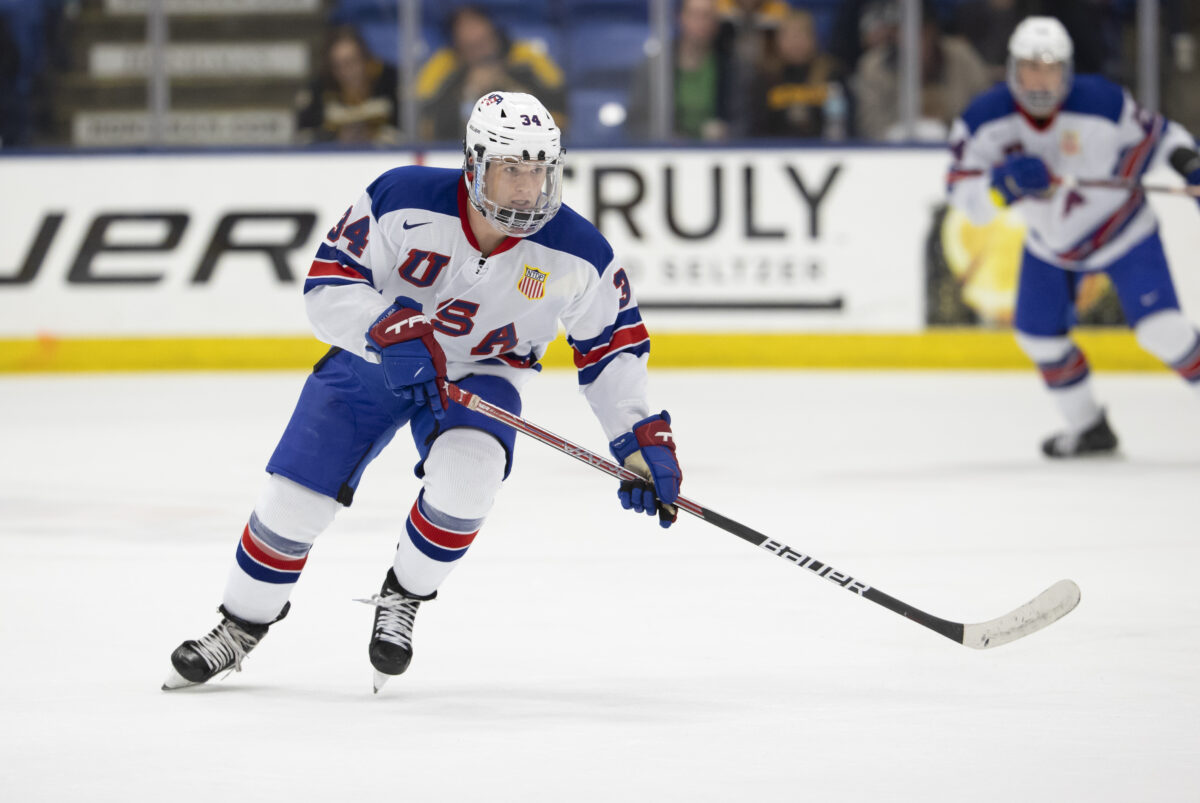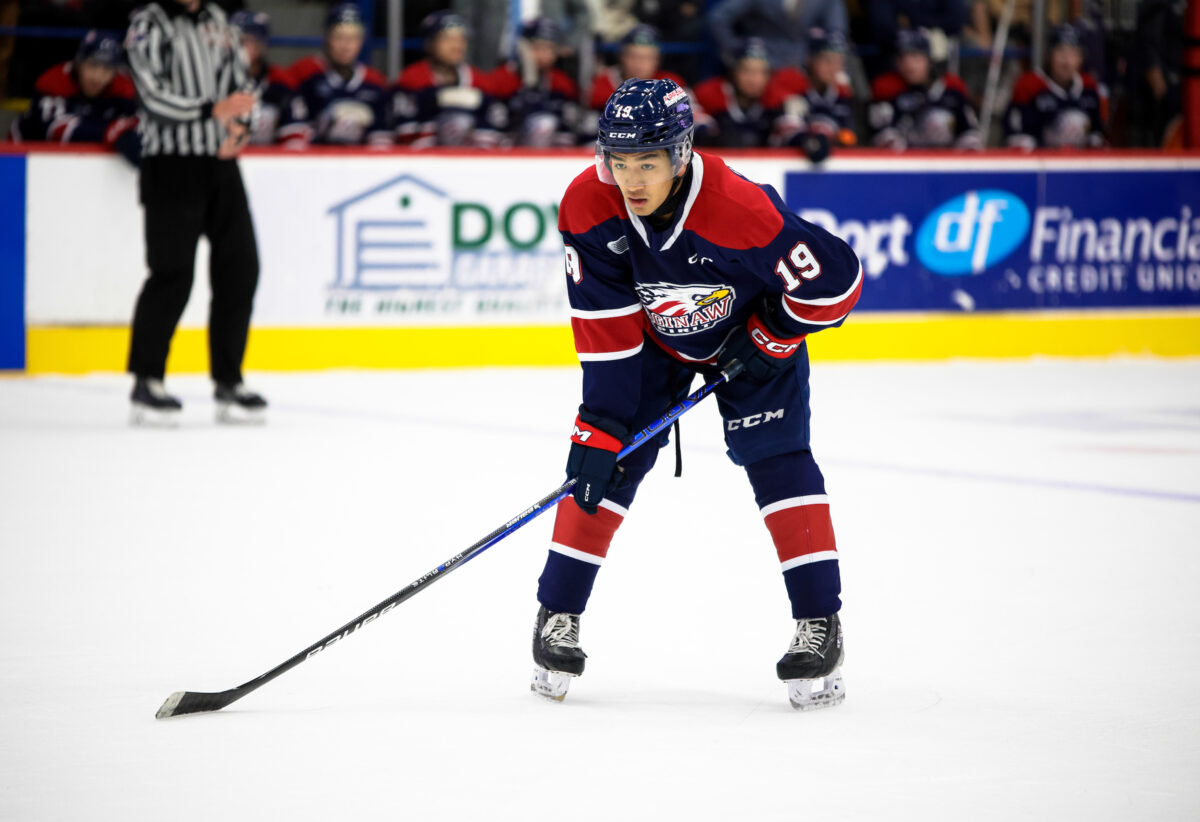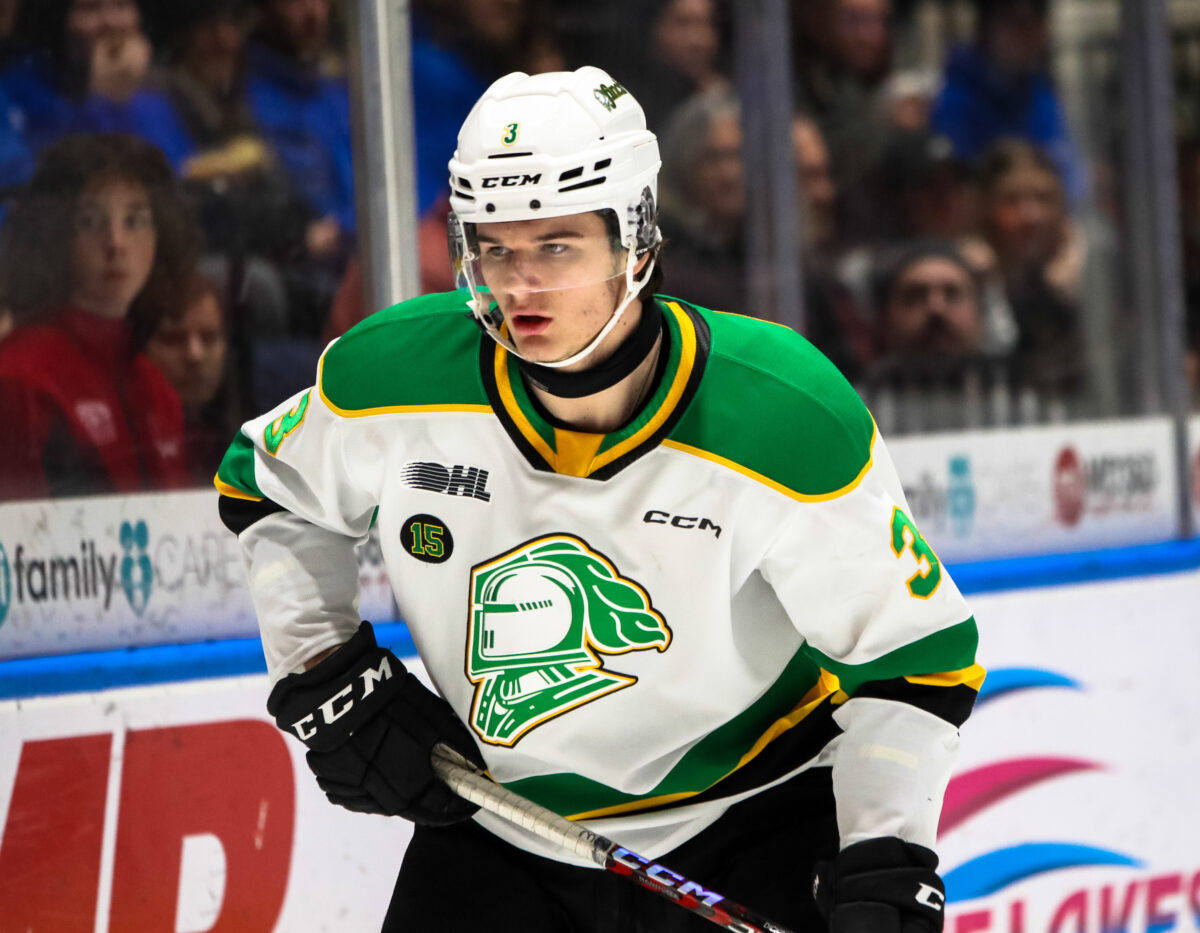The St. Louis Blues’ season has not gone according to plan, but they’re in the position most expected them to be. They’re sitting in the middle of the pack, in ninth place in the Western Conference, and six points out of the second wild-card spot. Although they have a puncher’s chance at making the postseason this year, it is more likely that the team will again pick in the lottery during the NHL Entry Draft. Barring a late-season push, the Blues are slated to miss the postseason for the second straight season, and their attention will turn towards the NHL Draft in June.
Related Article: Blues’ Prospect Jimmy Snuggerud’s Floor & Ceiling
General manager Doug Armstrong has been open about his intention to stay competitive while retooling this roster. Given the Blues’ inconsistent play this season, the team is expected to make significant shakeups to its core in the off-season, and rightfully so. With the debuts of 2021 first-round pick Zachary Bolduc and the rise of 2020 fifth-round pick Matthew Kessel, the Blues have started giving young players a shot to prove their worth in the NHL to see what the foundation of the team could look like for years to come. With the call-up of Zach Dean, the former first-round pick acquired in the Ivan Barbashev trade from the Vegas Golden Knights, who is expected to make his NHL debut soon, the youth movement is taking over St. Louis.
Not only does the organization have several prospects and young players emerging on the NHL roster and making impacts, but several prospects remain in the pipeline who have yet to make their debuts and are expected to become impact franchise cornerstones.
Atop of that list is 2022 first-round pick Jimmy Snuggerud, who has a shot compared to the likes of Alex DeBrincat and Vladimir Tarasenko and has the potential to be a perennial 30-goal scorer for the Blues. Centers Dalibor Dvorsky and Otto Stenberg are looked at as the replacements for Brayden Schenn and Kevin Hayes as the team’s middle six centerman, with Dvorsky having elite offensive traits and dominating the Ontario Hockey League (OHL) this season with 38 goals and Stenberg showcasing great versatility at this year’s World Juniors, the Blues have some promising young talent on the roster.
With the team trending toward missing the playoffs, fans’ focus has become the team’s first-round pick and what management could do with another top-12 selection. Looking at the draft, this class is intriguing, with multiple potential superstars and several really good NHL-caliber players. It does allow Armstrong to truly round off his prospect pool with another potential lottery pick. While the team is currently slated to pick 12th in the upcoming draft, the team is only five points ahead of the teams slated to pick eighth and nineth right now, and with their current play declining (4-5-1 in their last 10), the team could be moving towards prime lottery selection. With the draft creeping closer and closer, there are a few prospects that Armstrong and the Blues should keep their eyes on for the roster if they find themselves picking in the lottery this summer.
Cole Eiserman (USNDP) LW
Cole Eiserman is one of this upcoming draft’s most polarizing and dynamic prospects. At just 17 years old, he’s scored 45 goals in 43 games for the United States Development Program and has showcased one of the most lethal shots coming out in recent memory. His ability to score is what makes him such an intriguing player. He is not the most polished skater and has not shown the ability to anchor his own line, but the incredibly high offensive upside alone will make him a sure-fire top-10 pick. He seems to have some doubters within his play outside of shooting the puck. He has not demonstrated the ability to play make for others or generate his own offense, often feeding from great passes and plays made by his teammates. Still, he can benefit if he goes to a team with dynamic playmaking ability. Eiserman can become a legit 40-goal scorer in the NHL if he is paired with dynamic players.

This reasoning is why the fit with the Blues is a fascinating one. The Blues currently rank 31st in five-on-five goals percentage and 28th in goals for per 60 minutes. The team lacks shooting and offense; adding Eiserman to a team full of dynamic playmakers who have showcased excellent passing skills would benefit both Eiserman and the team equally. Playing alongside players like Robert Thomas and Jordan Kyrou, who have shown an outstanding ability to create offense for other players, would allow Eiserman to play the role of a scoring forward who could finish from any angle. The team needs offense, and it is no secret that the Blues have yet to receive enough offensive contributions from their three secondary lines this season. Adding Eiserman to the draft would give the team another lethal shooter in the system alongside Bolduc and Snuggerud, which would finally provide the Blues offense and a shooting mentality throughout their forward core.
To draft Eiserman, the Blues would likely have to tank completely in the standings for the rest of the season or get some significant lottery luck. However, there is a world where the winger does fall in the draft because his 200-foot game is weaker than some of his counterparts. If he gets within striking distance for Armstrong and the Blues, he is a player the team should covet and strongly consider taking.
Zayne Parekh (Saginaw Spirit/OHL) RHD
The Blues roster will undergo significant changes this offseason, and the team’s defense core will undoubtedly be changed. The main reason for mediocrity is the poor play of players getting paid top dollar. Many of those players are on the Blues defense, with Justin Faulk and Torey Krug underperforming their long-term contracts. Both were brought in to help stabilize the blue line after Alex Pietrangelo’s departure but have yet to live up to expectations.
When looking at the defenseman on the roster, a lack of offense is generated from the top of the point, which could lead to the Blues trying to find an answer. For the last several seasons, the Blues have been trying different pairings for veteran Colton Parayko, and although Nick Leddy has been decent this season, he is not a long-term answer on the top line.

The team invested in Theo Lindstein last year with the last of their three first-round picks this past summer. He is an offensive-minded defenseman with excellent puck-moving skills, but outside of him, the Blues need more true dynamic prospects on their blue line. Lindstein is also a tough projection to the NHL. He has excellent puck-moving ability and makes intelligent decisions with the puck. Still, Lindstein’s ceiling is more along the lines of a top-four defenseman than a top-line guarantee.
When considering Zayne Parekh as a potential fit for the Blues, it is all about his offensive ability and incredibly high offensive ceiling. Parekh is currently on a scoring tear in the OHL with 87 points in 61 games and has showcased elite playmaking and goal-scoring abilities during his time with the Saginaw Spirit. What he does well is generate offense from the point, and this team needs more of it.
Parekh does not have a complete, well-rounded 200-foot game, but with his skating ability and movement skills combined with his high-level instincts to make plays, the defensive side of the game will develop as he continues to get older. What the 18-year-old does bring to the table is elite power play potential and an ability to generate offense, which is something the Blues still need to establish on the roster.
Parekh would be a high-upside potential pick for the Blues. He could be the offensive-minded playmaker with elite power play movement that the team thought they were getting when they signed Torey Krug several seasons ago. Whether he turns into a true top-line player is yet to be determined. Still, with the struggles of the power play and scoring, in general, this season, the addition of an offensive-minded puck mover like Parekh is exactly what this team could use to get to the next level.
Sam Dickinson (London Knights/OHL) LHD
As mentioned, the Blues’ defensive core is expected to be shaken up this offseason, and in a defense-heavy draft, this is the perfect class to bring in some blue-chip players on the blue line. What concerns many Blues fans is not only the performance of the current NHL roster but the need for some true NHL-level defenseman currently in the prospect pool. Outside of Lindstein, the team has no top-four potential defenseman prospects in the pipeline. Kessel has been a pleasant surprise this season and has played well, but ideally, he is a bottom-pairing defenseman with upside on a deep team. With Armstrong looking to move one or more of his defenseman contracts in the offseason, adding depth within the pipeline that can impact the NHL roster very soon must be a top priority.

The most complete defenseman in this year’s class is Sam Dickinson from the London Knights. Currently playing in the OHL, Dickinson has showcased many great traits that make him a top-10 lock this summer, and he could go as high as pick three. What intrigues many teams and analysts about the 17-year-old is his prototypical size and overall intangibles. At 6-foot-3 and approaching 195 pounds, he has the size and speed combination that NHL teams love when building their rosters.
Dickinson is an all-around player who, at only 17, has a ton of potential and projects to be a top-pairing defenseman. He is an intelligent player responsible in his own zone and, on the offensive end, is a dynamic playmaker who can generate a ton of offense. If he were not playing on the same team as Philadelphia Flyers prospect Oliver Bonk, his point total would be much higher, but Bonk is the primary power-play defenseman, so that cuts into his time to generate offense. Even still, Dickinson is a point-per-game player for the Knights with 66 points in 63 games. Dickinson could use his body a little better as he is sometimes too shy to defend using his body and prefers using his stick, but at just 17 years old, he can develop into trusting his instincts and body more. That said, Dickinson’s high floor intrigues many analysts, and his ceiling is still significantly high because of his young age. He will only continue to grow.
Pairing him inside the top four would bolster the Blues’ defense core and give Parayko some stability inside the top four of his unit, which he has yet to have since he took over as the top guy on the defensive side of the ice.
Time To Get Aggressive
All of these prospects have the potential to go inside the top three and will almost certainly be gone by pick ten by the NHL Entry Draft in June, but that should not stop the Blues from targeting these players. All three fit and fill different needs for the team, and Armstrong should get aggressive in trying to position himself to select one of these players. Unless the team continues to freefall in the standings, the likelihood of the Blues having the opportunity to choose these blue-chip prospects is low. However, with the roster seemingly a few pieces away from competing and management adamant that changes are coming, getting aggressive to acquire a bonafide top-end talent in this draft should be strongly considered by Armstrong and his team this summer.
With players like Snuggerud, Dvorsky, Stenberg, Lindstein, and even Bolduc going to be mainstays on the roster in the seasons to come, adding a top-tier blue-chip player to combine with the depth of excellent prospects the Blues have amassed over the last few seasons, would push this pipeline to the next level. Plus, it would give the Blues a significant boost at getting out of the mediocre cycle they have caught themselves in over the last few seasons. In a draft where the elite prospects are less plentiful than in past seasons, this is the year for the team to speed up their retooling and build themselves a contender.
